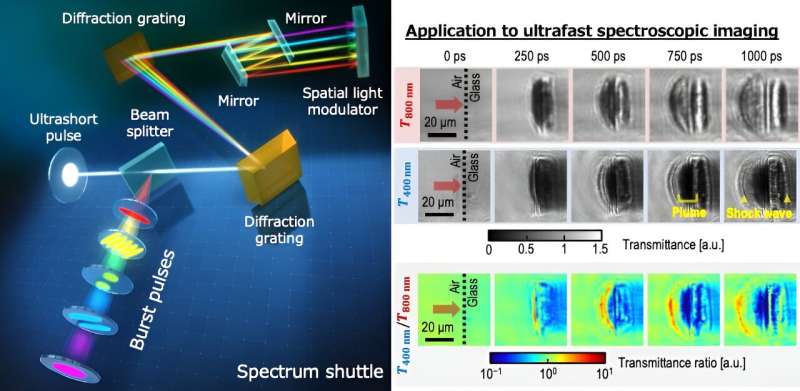The proposed “spectrum shuttling” method generates gigahertz (GHz) burst pulses from ultrashort pulses, each with a different wavelength and customizable spatial profile. These GHz bursts open the way to a variety of optical applications, including ultrafast imaging in the GHz range and high-quality and high-throughput laser processing using ultrashort laser pulse bursts. Image credit: K. Nakakawa (University of Tokyo).
The generation and manipulation of highly repetitive pulses holds great promise in a variety of applications, including high-speed photography, laser processing, and sound wave generation. Gigahertz (GHz) burst pulses with intervals ranging from ~0.01 to ~10 nanoseconds are particularly valuable for visualizing ultrafast phenomena and improving laser processing efficiency.
While there are methods to generate GHz burst pulses, challenges remain, such as low throughput of pulse energy, poor tunability of pulse intervals, and the complexity of existing systems. Furthermore, shaping the spatial profile of each GHz burst pulse faces limitations due to insufficient response of the spatial light modulator.
To address these challenges, a research team from the University of Tokyo and Saitama University developed an innovative optical technology called “spectrum shuttle” that is capable of simultaneously generating GHz burst pulses and individual shaping of their spatial profiles.
This method involves horizontally dispersing ultrashort pulses through a diffraction grating, using parallel mirrors to spatially separate the pulses into different wavelengths. These vertically aligned pulses are individually spatially modulated using a spatial light modulator. The resulting modulated pulses have varying time delays in the GHz range, producing spectrally separated GHz bursts, each with a unique shape in its spatial profile.
It is reported Advanced Photonics Nexus, the proposed method successfully generates GHz burst pulses with discrete variations in wavelength and time interval. It demonstrates the shaping of spatial contours, including positional shifts and peak splitting.
The application of this method to ultrafast spectral imaging demonstrates its ability to capture the dynamics of different wavebands simultaneously.
This method facilitates ultrafast imaging on subnanosecond to nanosecond time scales, enabling analysis of fast, non-repetitive phenomena. Potential applications include discovering unknown ultrafast phenomena and monitoring fast physical processes in industrial settings. The ability to individually shape GHz burst pulses also holds promise for precision laser processing and laser therapy.
Notably, the method’s compact design enhances its portability, making it suitable for use in scientific research facilities and various industrial technology fields.
“Our unique optical configuration allows manipulation of ultrashort pulses through three-dimensional optical paths, enabling unprecedented spatial manipulation of GHz burst pulses,” said Dr. Keitaro Shimada. candidate in the Department of Bioengineering, University of Tokyo.
“Spectrum Shuttle provides a variety of GHz burst pulses with intervals ranging from 10 picoseconds to 10 nanoseconds. I believe that applications based on our technology for various targets such as plasmas, metals and cells will accelerate scientific discovery and technological innovation in industry and the medical field.”
This innovative technology opens the way to advance ultrafast imaging, with implications for both scientific research and industrial applications. Its ability to simultaneously generate and shape GHz burst pulses provides a versatile tool for studying fast phenomena and enhancing laser-based processes.
More information:
Keitaro Shimada et al., Spectral shuttle for generating spatially shapeable GHz bursts, Advanced Photonics Nexus (2023). DOI: 10.1117/1.APN.3.1.016002
citation: Research team develops optical technique to simultaneously generate and shape gigahertz burst pulses (2023, December 19), Retrieved December 21, 2023, from https://phys.org/news/2023-12-team -optical-technique-simultaneously-gigahertz.html
This document is protected by copyright. No part may be reproduced without written permission except in the interests of fair dealing for private study or research purposes. Content is for reference only.
#Research #team #develops #optical #technology #simultaneously #generate #shape #gigahertz #burst #pulses
Image Source : phys.org
